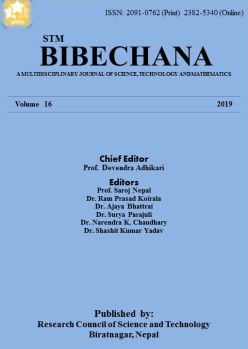Morphological study on particulate matter of Kathmandu valley
DOI:
https://doi.org/10.3126/bibechana.v16i0.19190Keywords:
Particulate matter, bight field optical microscopy, dust samples, aspect ratio.Abstract
Air borne particulate matter (PM) depending on size, shape, concentration, and chemical composition can cause multitude of health issues. In this study, we report the morphological study of dust samples obtained from twenty different locations of Kathmandu valley by imaging the sample directly by a bright field optical microscope. We find that the average size of particles in all the samples examined below 10 micrometer. Individual examination of particles revealed that significant number of particles asymmetric. The observation of asymmetric particles having aspect ratio as high as 20 may suggest that asbestiform particles exist in all the dust samples examined.
BIBECHANA 16 (2019) 41-46
Downloads
Downloads
Published
How to Cite
Issue
Section
License
This license enables reusers to distribute, remix, adapt, and build upon the material in any medium or format for noncommercial purposes only, and only so long as attribution is given to the creator.




